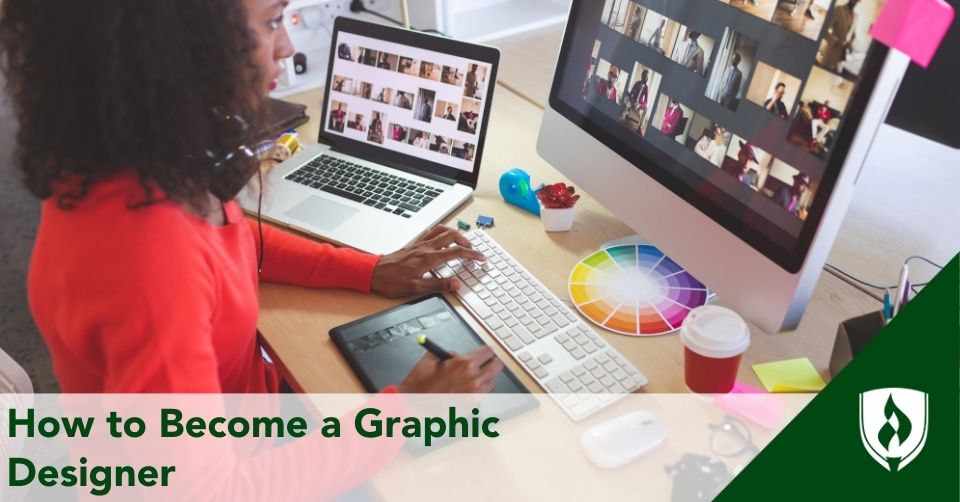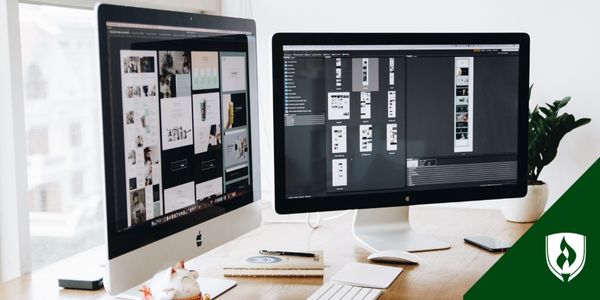How To Become a Graphic Designer
09/05/2025

If you’re wondering how to become a graphic designer, you’re likely drawn to a career that blends creativity with practical communication. Graphic design is on the websites you scroll through, the marketing materials in your mailbox, the social media graphics and videos in your feed, and the logos that make brands instantly recognizable.
Graphic designers take1 concepts and translate them into visual representations that connect with audiences. They combine artistic talent with technical skills to create designs that are both visually appealing and purposeful. Whether working with a creative team inside a company, collaborating with art directors and other designers at a marketing agency, or pursuing independence as a freelance graphic designer, graphic design professionals contribute to the way people experience and understand information.
If you’re ready to move forward, here’s a step-by-step look at the graphic design career path, including education, skills, and career options as well as how a graphic design degree can help aspiring graphic designers prepare for this versatile industry.
Graphic Design Education and Qualifications
Most graphic designers pursue structured education2 to build the blend of artistic ability and technical training needed to succeed. While some may start with personal projects or online courses in specific tools, a graphic design degree offers the foundation of knowledge and applied skills employers expect.
At Rasmussen University, students can choose3 between two pathways:
- An associate degree in Graphic Design4 that emphasizes design principles, visual communication, and disciplines like Adobe® Creative Cloud, web design, digital image editing and more.
- A bachelor’s degree in Graphic Design5 that expands on those fundamentals with advanced coursework, digital media design, and opportunities to prepare for the Adobe® Certified Associate in Visual Communication in Photoshop® and the Adobe® Certified Associate in Digital Video Using Premiere Pro.
Both graphic design programs are offered online, allowing students to learn at their own pace while balancing education with work or personal commitments.
Formal education also introduces students to learn skills and knowledge to analyze and create unique visual solutions to real-world communication problems. Unlike casual learning through tutorials, these programs3 provide access to instructors who are accomplished design professionals who have received industry awards and accolades for their work.
Developing Graphic Design Skills
To become a graphic designer, you’ll need to strengthen a mix of artistic skills and technical skills. These may include:
- Critical thinking3 and analytical skills:2 Students learn to view their work from the audience’s perspective, ensuring designs effectively communicate the client’s message.
- Digital fluency3 and computer skills:2 Hands-on experience with industry-standard design software prepares students to create professional-quality designs.
- Creativity and artistic ability:2 Students develop visually engaging designs and explore innovative approaches to convey ideas.
- Communication skills:2,3 Coursework emphasizes clear communication with clients, peers, and other professionals to ensure accurate information delivery.
- Collaboration and ethics:3 Students build teamwork abilities and professional responsibility, preparing them to work effectively in diverse environments.
- Time-management skills:2 Managing multiple projects and deadlines helps students develop organizational skills essential in professional design work.
Students in Rasmussen’s programs complete design projects that reinforce these skills while contributing to a graphic design portfolio. Portfolio projects created in the program are intended to help students demonstrate their learning; individual outcomes may vary.
Learning Graphic Design Principles
Behind every polished design lies a framework of rules and guidelines. Design principles6 help creative professionals decide how to arrange design elements such as line, shape, and color.
Courses in Rasmussen’s graphic design program4 explore these principles through courses like digital photography and image editing, web design fundamentals and graphic design portfolio. Students learn how to apply color theory to evoke emotion, how to tell a story with a photo, and how to build visual representation that aligns with a client’s goals.
This understanding may help students prepare for roles in the graphic design industry, where they’ll often need to explain2 their creative choices not just to other designers, but to clients, marketing teams, and creative directors who may not have formal design training.
Enrolling in Graphic Design Courses
Aspiring graphic designers often start with online courses to explore specific tools, but enrolling in a full graphic design degree program provides broader preparation. At Rasmussen University, the curriculum for each respective graphic design program covers both creative and professional needs. Students gain experience with:3
- Visual design and theory through coursework in studio art and visual communication
- Design software training using current design software
- Design projects that contribute directly to a graphic design portfolio
- Exposure to digital media design, including motion graphics and web design
Learning in a structured graphic design program also introduces students to peer collaboration. Just as graphic designers work in teams in professional environments, students work alongside other graphic designers in the classroom to gain feedback and learn to critique effectively.
Career Paths for Graphic Designers
The graphic design industry offers a variety of paths. Some graphic designers hold positions7 in advertising or marketing agencies where they work with creative teams that include copywriters, strategists, and art directors. Some choose to work in specialized design services, such as packaging or digital media design.
According to Rasmussen, graduates may be qualified to seek roles such as:8
- Graphic designer
- Visual designer
- Graphic artist
- Production artist
- Junior graphic designer
- Design specialist
- Visual information specialist
- Graphic specialist
- Creative graphics designer
- Digital designer
- Print designer
- Motion graphics designer
- Visual media producer
- Marketing coordinator/specialist
- Web designer
- Video editor
These roles can involve designing webpages, creating social media graphics, producing visual concepts for campaigns, or developing layouts for marketing materials. Some designers choose to specialize in areas like web design, user experience or user interface (UI/UX) design or branding.
Working as a Freelance Graphic Designer
For those seeking independence, becoming a freelance graphic designer9 is another option. Freelancers often work independently with clients, choosing projects that align with their interests. This flexibility can be appealing, but it requires additional skills:
- Managing contracts and invoicing
- Marketing services to attract new clients
- Balancing multiple deadlines
A strong graphic design portfolio is especially important for freelancers, since potential clients evaluate work samples before committing. Rasmussen’s programs3 emphasize portfolio development, allowing students to graduate with work they can share immediately with clients or potential employers.
Finding Graphic Design Jobs
When it comes to finding opportunities, graphic designers work across industries. Many positions are posted on job boards, but referrals, networking, and building visibility online can be just as valuable. Strategies include:
- Creating an online portfolio that features both coursework and personal projects
- Engaging on professional platforms to connect with creative professionals and other graphic designers
- Pursuing certifications, such as Adobe® Certified Professional,5 to demonstrate expertise in design software
Communication designers also benefit from understanding1 how to collaborate across teams. In many companies, graphic designers collaborate with web developers, marketing specialists, and creative designers to ensure visuals align with brand strategy.
How To Create a Graphic Design Career Path
A graphic design career doesn’t look the same for everyone. Some designers7 find their niche in agencies, others thrive in corporate environments, and some carve out space as freelancers. Whatever the direction, building a plan is essential.
Here are a few steps to consider:
- Assess your artistic talent and strengthen technical skills through structured training.
- Enroll in a graphic design program that provides structured learning and portfolio development.
- Use personal projects to explore your creative style and broaden your portfolio.
- Build connections with other designers and creative professionals.
Rasmussen University’s Graphic Design degree programs3 combine design theory, digital media design, and professional preparation. Students finish with not just knowledge, but a body of work that reflects their design skills and creative perspective.
Prepare to Build Your Future in Graphic Design
If you’re ready to move forward in learning how to become a graphic designer, consider how formal education could help you develop your design skills and create a portfolio that represents your abilities. Rasmussen University’s online graphic design courses3 provide opportunities to explore visual media, practice with design software, and build projects that reflect your growth.
With the right preparation, aspiring graphic designers can take the next step toward exploring a path in the graphic design industry.
Explore Rasmussen University’s Graphic Design degree options3 today and see how structured learning can help you grow as a creative professional.
Adobe®, Adobe® Photoshop® and Adobe® Lightroom® are either registered trademarks or trademarks of Adobe® in the United States and/or other countries.
1U.S. Bureau of Labor Statistics, “Graphic Designers: What They Do,” Occupational Outlook Handbook, https://www.bls.gov/ooh/arts-and-design/graphic-designers.htm#tab-2 (accessed August 18, 2025). Employment conditions in your area may vary.
2U.S. Bureau of Labor Statistics, “Graphic Designers: Job Outlook,” Occupational Outlook Handbook, https://www.bls.gov/ooh/arts-and-design/graphic-designers.htm#tab-4 (accessed August 18, 2025). Employment conditions in your area may vary.
3Rasmussen University, “Graphic Design Degrees,” https://www.rasmussen.edu/degrees/design/graphic-design/ (accessed August 18, 2025).
4Rasmussen University, “Graphic Design Associate's Degree Online,” https://www.rasmussen.edu/degrees/design/graphic-design/associates/ (accessed August 18, 2025).
5Rasmussen University, “Graphic Design Bachelor's Degree Online,” https://www.rasmussen.edu/degrees/design/graphic-design/bachelors/ (accessed August 18, 2025).
6“8 Basic Design Principles to Help You Create Better Graphics,” Adobe® Express, https://www.adobe.com/express/learn/blog/8-basic-design-principles-to-help-you-create-better-graphics (accessed August 18, 2025).
7U.S. Bureau of Labor Statistics, “Graphic Designers: Work Environment,” Occupational Outlook Handbook, https://www.bls.gov/ooh/arts-and-design/graphic-designers.htm#tab-3 (accessed August 18, 2025). Employment conditions in your area may vary.
8Rasmussen University, “2025–2026 Academic Catalog,” https://rasmussen.dcatalog.com/v/2025-2026-Catalog/?page=36 (accessed August 18, 2025).
9Delavani, Evina, and Addin Linando, Jaya. Freelancers in the Creative Industries: An In-Depth Analysis of Flexibility and Uncertainty, ORCADEV Journal, https://journals.researchsynergypress.com/index.php/orcadev/article/view/3266 (accessed August 18, 2025).



